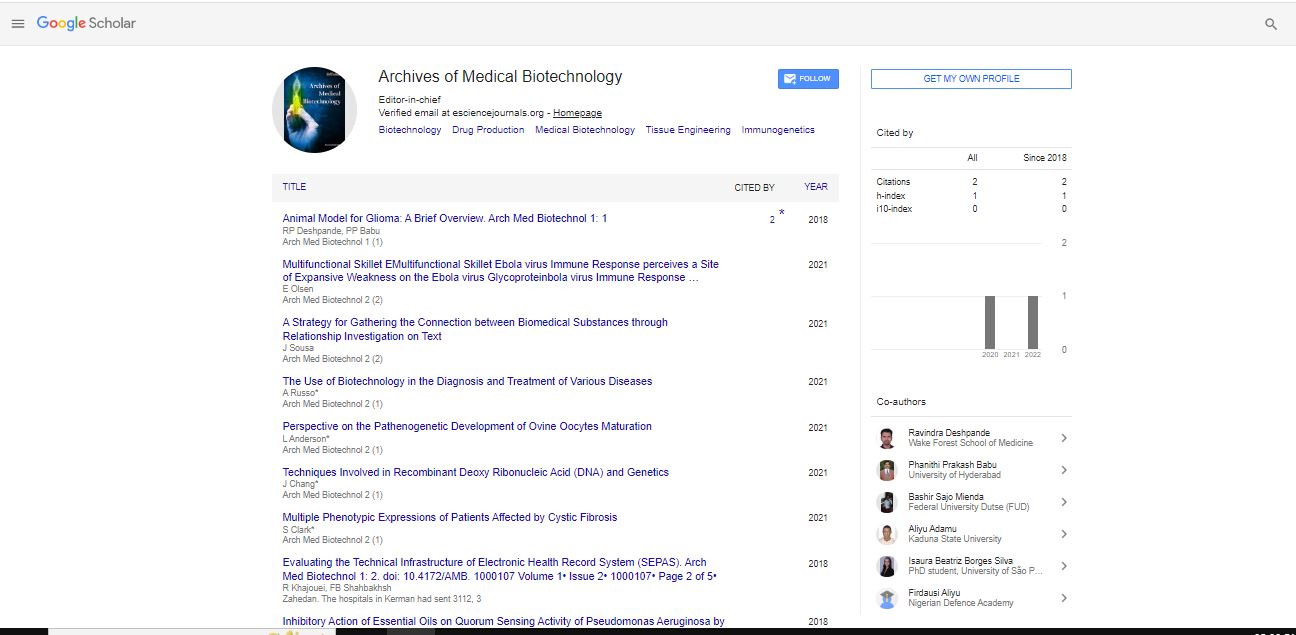Commentary, Arch Med Biotechnol Vol: 3 Issue: 2
Human Genome Variant and Human Disease
Raju Kumar*
Department of Biotechnology, Rajiv Gandhi Centre for Biotechnology, Thiruvananthapuram, India
*Corresponding Author:Raju Kumar
Department of Biotechnology, Rajiv Gandhi Centre for Biotechnology, Thiruvananthapuram, India
Email: raju23@gmail.com
Received date: 01 March, 2022, Manuscript No. AMB-22-59970;
Editor assigned date: 04 March, 2022; Pre QC No. AMB-22-59970 (PQ);
Reviewed date: 14 March, 2022, QC No. AMB-22-59970;
Revised date: 23 March, 2022, Manuscript No: AMB-22-59970 (R);
Published date: 30 March, 2022, DOI: 10.4172/amb.1000024.
Keywords: Disease
Introduction
In the direction of the give up of the remaining millennium, remarkable boom inside the sophistication of the biological sciences was harnessed in medicine, the food industry, and related bio industries. New discoveries and improvements in organic sciences throughout a long time prior to the 21st century have focused on genetics and genomics. It took simply over 50 years following the unraveling of the shape of the molecule of nucleic acids, the key unit of the organic lifestyles, for scientists to embark on sequencing of foremost organism’s entire genetic charter or genome. The phrase genome consists of gene and omen, implying complete expertise of all genes and associated elements in any unmarried organism. Inevitably, this caused enthusiastic expansion of the entire technological know-how and thence to the emergence of genomics. It, derived from the historical Greek, refers to in-intensity knowledge. Not fantastically, genomics turned into observed through a plethora of related-omics, for example, proteomics, metabolomics, and transcriptomics. Presently, we've got over 30 such disciplines with the omics suffix. The last aim of any medical area is its translation for the advantage of all human beings, crossing all feasible barriers and barriers. Primary advances in remedy and health have been only feasible via understanding fundamental concepts and mechanisms underlying disorder techniques. This turned into facilitated via rapid applications of bodily and chemical sciences in remedy and health, for example, X-ray diagnostics, ultrasound prognosis, microbiology diagnosis, immunohistochemical analysis, and ultimately, molecular prognosis. traits and advances in genetics have caused a better expertise of the concepts governing heredity and the familial transmission of bodily characteristics and diseases, better know-how of the pathophysiology of sicknesses, the development of recent strategies of clinical and laboratory diagnosis, and modern tactics to making early diagnoses (e.g., prenatal diagnoses and newborn screening) and presenting reproductive selections, consisting of preimplantation genetic diagnoses. A lot of these developments are now usual within the broad fields of human genetics, scientific genetics, scientific genetics, genetic remedy, and new rising subject of genomic medicine. Now not notably, the sphere stays huge open, encompassing the large field of human genomics extensively focusing on clinical and health genomics. This bankruptcy leads the e book supplying the primary authentic records for grasping the concepts of heredity, genes, genetics, and genomics. Its miles predicted that the reader will proceed to next chapter’s higher ready with the creation to genetic/genome sciences, genetic illnesses, genetics and genomics in remedy, programs in public fitness, and specific troubles associated with society, ethics, and regulation.
Human Genome Variant and Human Disorder
The arrival of recombinant DNA technology within the 1970s revolutionized our capability to represent and capitalize on the molecular basis of human genetic disease. This laid the muse of finally mapping and decoding the DNA sequence of all the structural and functional genes of the human genome. The Human Genome Project (HGP) turned into, consequently, an herbal progression from all previous trends inside the field of human genetics. This type of substantial project couldn't were carried out without the worldwide collective efforts supported by way of generous funding from governmental and nongovernmental sources. The mission (HGP) has helped map and offer nucleotide sequences of round 23,000 nuclear genes, which, along with some of different series versions, compose the complete human genome. Although a large variety of the nuclear genes were assigned with a structural or functional hyperlink, an appropriate role of different elements of the genome is not yet absolutely understood. But, HGP presents the basis for “practical genomics” to explore in addition the genome’s purposeful function and understand the complicated mechanisms through which genes and their products interact to have an effect on biological characteristic and have an impact on sickness strategies. The development of recent healing sellers is now possible on the idea of genomic arrangement and its targeted purposeful position. This approach also helps symbolize the genomes of diverse pathogens and other organisms, an invaluable tool in realizing the overall ability of this field to improve human health.
Measuring Genetic and Genomic Version
Humans have two genomes, nuclear and mitochondrial. Every day diploid cells include copies of the nuclear genome and a much larger but variable number of copies of the mitochondrial genome. Genetic and genomic version is plentiful in each genome. However, in preferred this implies to nuclear genome. The “finished” human genome collection became posted in 2004. Shows the modern fine estimates of the size and gene content material of each chromosome. These figures are for the human reference genome. There are hanging variations between the nuclear and mitochondrial DNA (mtDNA). They do not correspond precisely to the genome of any actual individual, because the genomes of wholesome normal individuals vary particularly in chromosome sizes and numbers of genes, as described subsequent. Neither is the reference genome in any experience a “perfect” human genome. It is surely an arbitrary and reasonably common reference factor for comparing human.
 Spanish
Spanish  Chinese
Chinese  Russian
Russian  German
German  French
French  Japanese
Japanese  Portuguese
Portuguese  Hindi
Hindi 